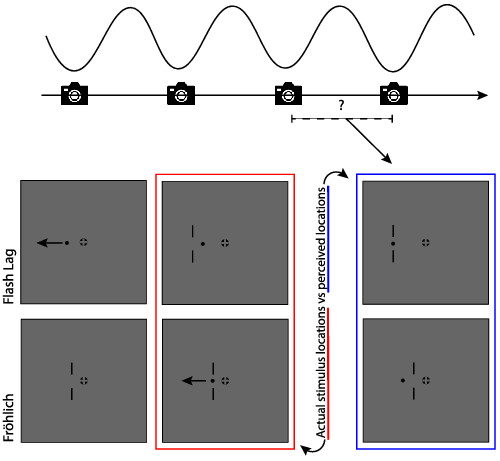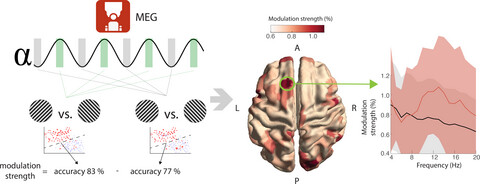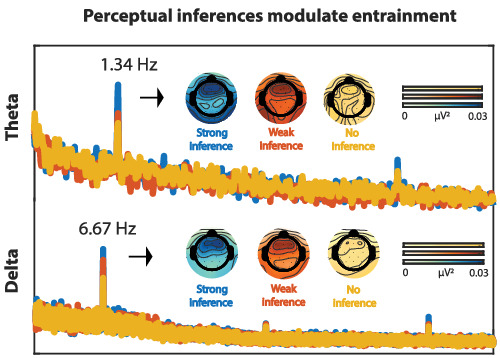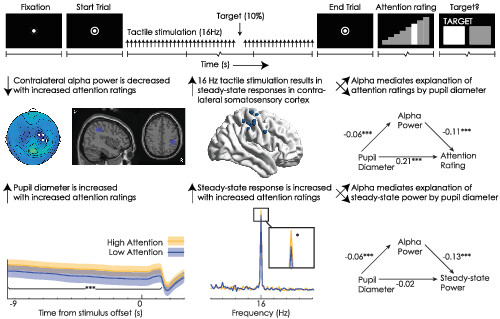Journal list menu
Export Citations
Download PDFs
ISSUE INFORMATION
SPECIAL ISSUE EDITORIAL
Rhythms in cognition: The evidence revisited
- Pages: 2991-3009
- First Published: 13 June 2022
SPECIAL ISSUE REVIEW
Rhythmic sampling revisited: Experimental paradigms and neural mechanisms
- Pages: 3010-3024
- First Published: 13 October 2021
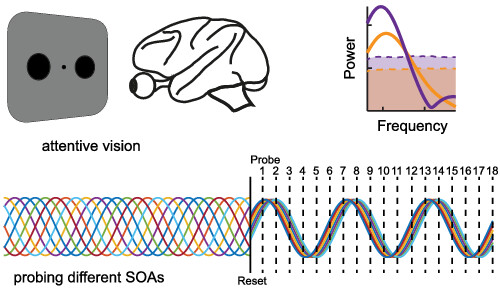
Rhythmic sampling of information is thought to be an important aspect of explorative behaviour. This review presents an overview on experimental conditions that are used to study rhythmic sampling and associated oscillatory brain activity during attentive vision. It provides guidelines to efficiently quantify behavioural rhythms, compares results from human and non-human primate studies and argues that the underlying neural mechanisms of sampling can co-occur in both sensory and high-level areas.
SPECIAL ISSUE ARTICLES
Distinct contributions of alpha and theta rhythms to perceptual and attentional sampling
- Pages: 3025-3039
- First Published: 20 February 2021
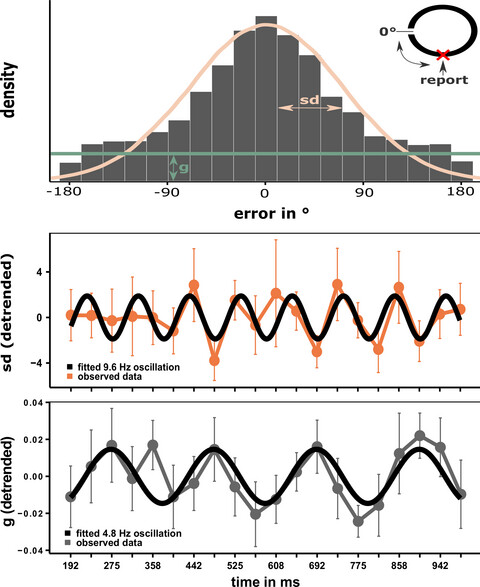
Visual perception operates in an oscillatory fashion at an alpha frequency, such that perceptual snapshots are taken at favorable phases of the rhythm. Visual attention also seems to operate rhythmically, albeit at a theta frequency. We provide evidence for distinct roles of the perceptual alpha and the attentional theta rhythm, suggesting that sampling is characterized by fluctuating spatial resolution rather than a strict succession of blind gaps and perceptual snapshots.
Shared resources between visual attention and visual working memory are allocated through rhythmic sampling
- Pages: 3040-3053
- First Published: 03 May 2021
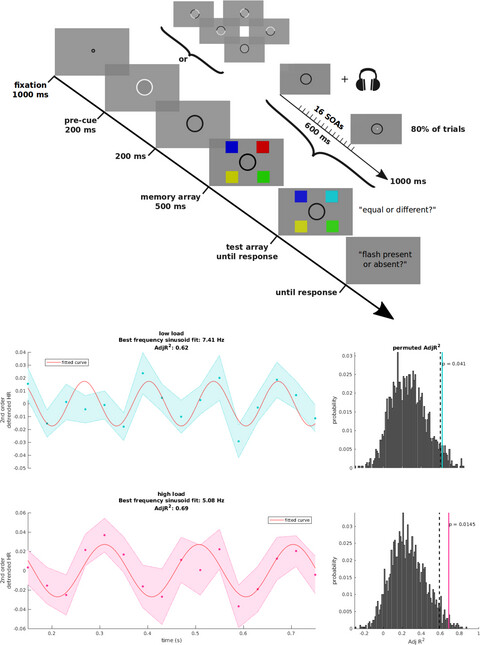
We probed visual detection capability of human participants (N = 22) while they had to maintain a variable number of items in visual working memory (VWM). A dense sampling approach allowed to disclose different rhythms associated with different VWM loads: Low load was associated with an oscillation in detection at ~7.5 Hz, whereas an oscillation at ~5 Hz was observed in higher VWM load. This pattern of results is consistent with a central sampling attentional rhythm that allocates shared attentional resources both to the flow of external visual stimulation and to the internal maintenance of visual information.
No evidence for a single oscillator underlying discrete visual percepts
- Pages: 3054-3066
- First Published: 19 June 2021
Attentional sampling of visual and auditory objects is captured by theta-modulated neural activity
- Pages: 3067-3082
- First Published: 02 November 2021
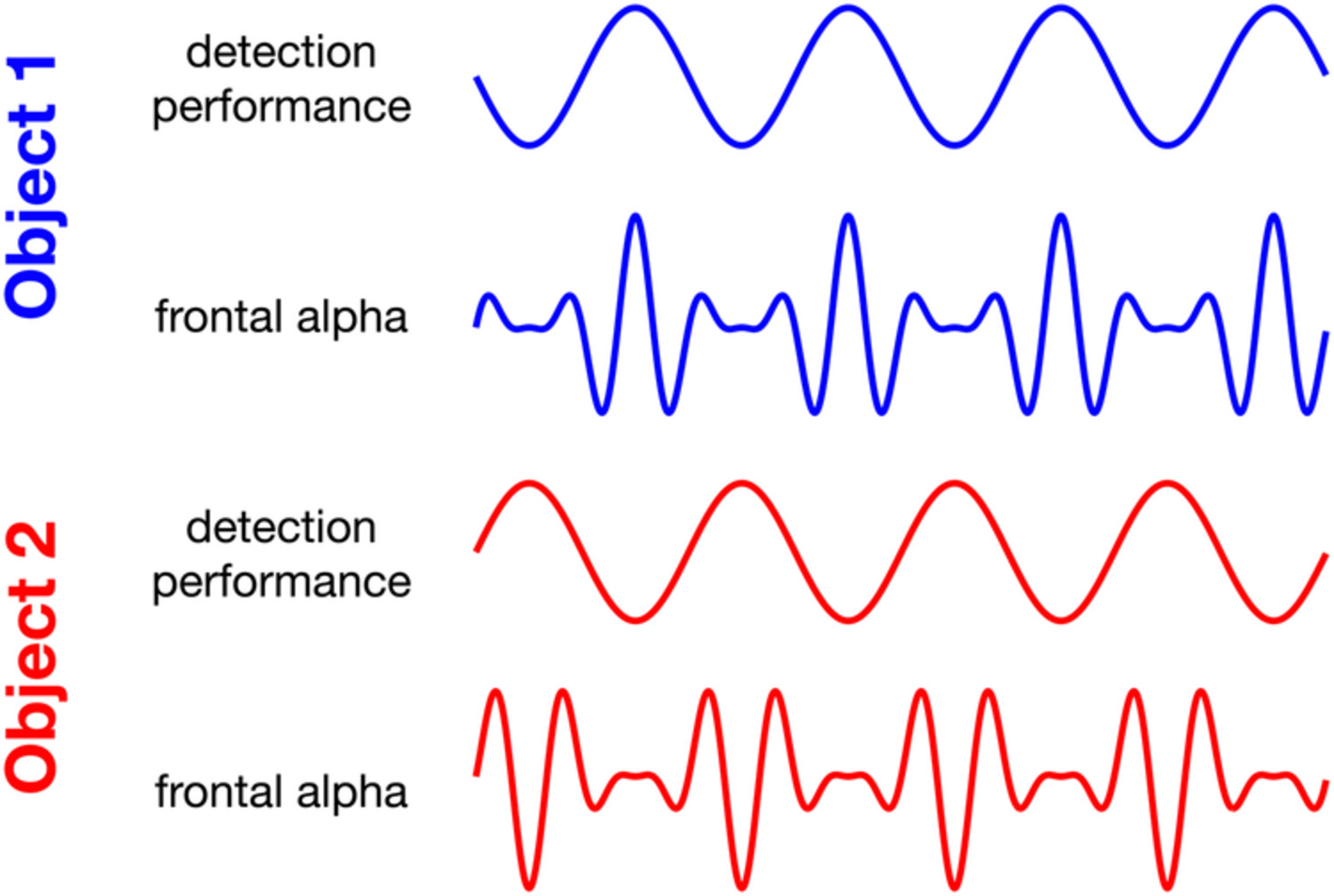
Employing an audio-visual detection task, we confirm that attention rhythmically oscillates between two objects at ~4–8 Hz and in counter-phase to each other. The effect was present in both the visual and the auditory modality and was also reflected in counter-phasic theta-modulations of frontal alpha power in the EEG.
Propagation and update of auditory perceptual priors through alpha and theta rhythms
- Pages: 3083-3099
- First Published: 08 February 2021
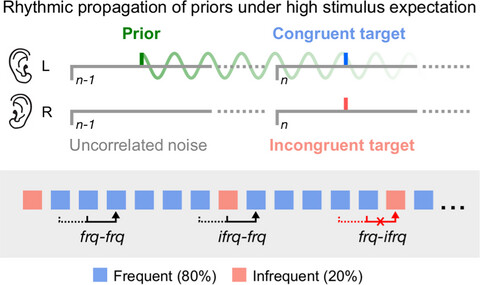
We asked participants to discriminate the ear-of-origin of a brief pure tone embedded in dichotic white noise and manipulated stimulus expectation by presenting the target with unequal probability to the two ears (80% vs. 20%). Our results show that even under high stimulus expectation, auditory perceptual priors are propagated via ear-specific reverberations, manifested as rhythmic fluctuations of decision bias at alpha frequencies (~9 Hz).
SPECIAL ISSUE ARTICLE
No evidence of rhythmic visuospatial attention at cued locations in a spatial cuing paradigm, regardless of their behavioural relevance
- Pages: 3100-3116
- First Published: 15 June 2021
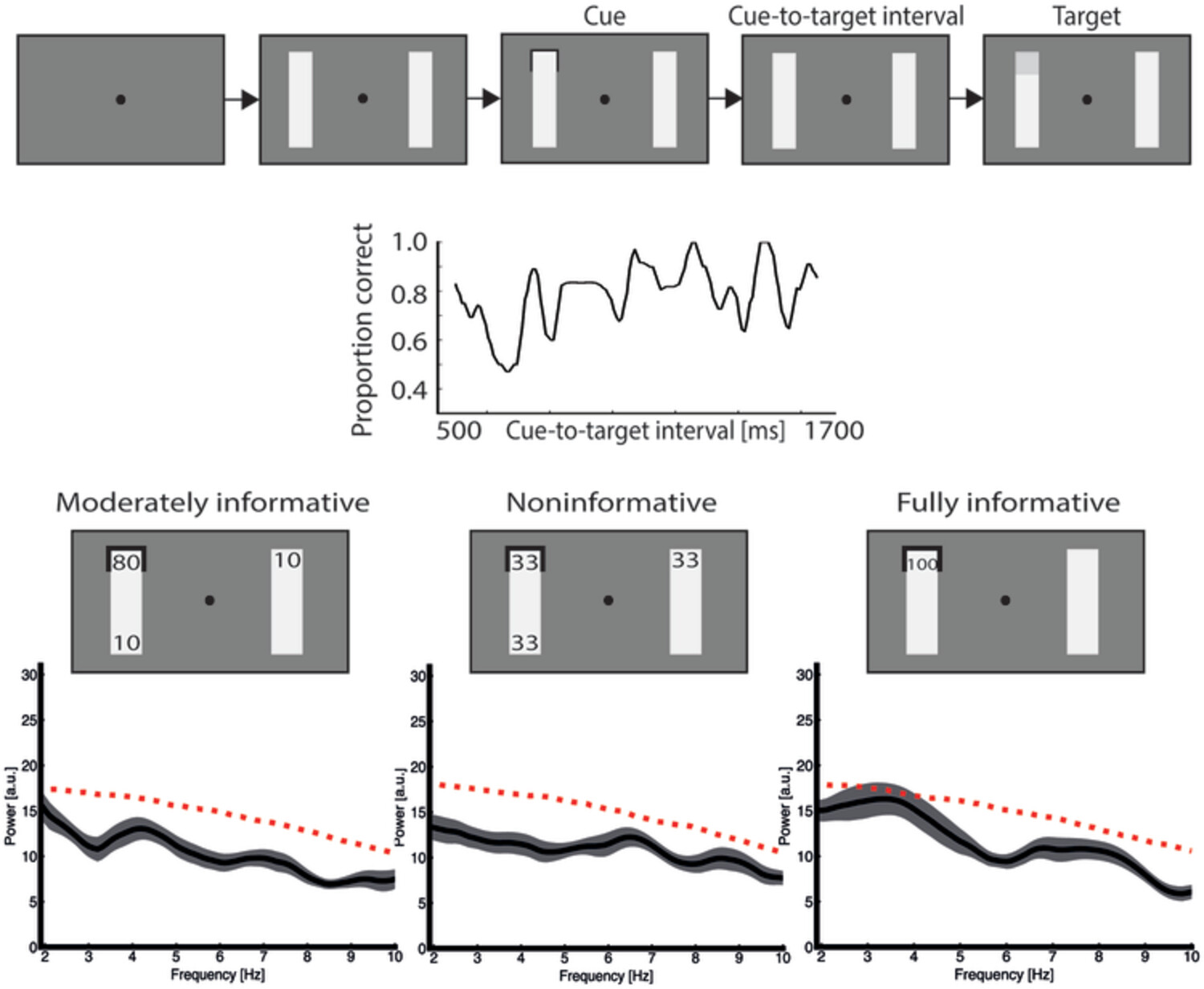
Here, we aimed to replicate recent work that showed rhythmic attention in a visual attention task. Also, we aimed show that rhythmic attention at the cued spatial location depended on the behavioural relevance of the cue. We nor found evidence for rhythmic attention at the cued location, neither found that rhythmic attention depended on the location's behavioural relevance.
COMMENTARIES
Detecting attention-related rhythms: When is behavior not enough? (Commentary on van der Werf et al. 2021)
- Pages: 3117-3120
- First Published: 26 May 2021
Absence of behavioural rhythms: Noise or unexplained neuronal mechanisms? (response to Fiebelkorn, 2021)
- Pages: 3121-3124
- First Published: 22 February 2022
SPECIAL ISSUE ARTICLES
Low pre-stimulus EEG alpha power amplifies visual awareness but not visual sensitivity
- Pages: 3125-3140
- First Published: 02 March 2021
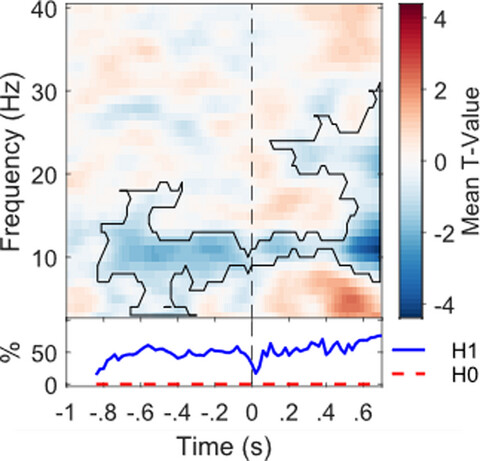
We employed a multiple-alternative forced-choice (m-AFC) discrimination task to study the single-trial EEG predictors of subjective reports of level of visual awareness, as well as accuracy. Our results replicate findings from a 2-AFC task, showing an inverse relationship between pre-stimulus alpha-power and visual awareness, but no link to discrimination accuracy. This confirms a dissociation between subjective and objective measures of performance, with pre-stimulus EEG power predicting the former.
Prestimulus alpha power but not phase influences visual discrimination of long-duration visual stimuli
- Pages: 3141-3153
- First Published: 05 March 2021
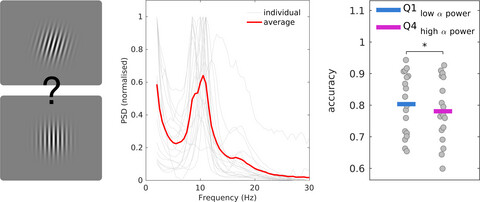
During an electroencephalography recording, participants were asked to distinguish upright from rotated visual gratings presented for up to 1,500 ms. The power of the individual alpha frequency at occipital electrodes influenced the perceptual accuracy. Reduced alpha power prior to stimulus onset resulted in more accurate perception.
To see, not to see or to see poorly: Perceptual quality and guess rate as a function of electroencephalography (EEG) brain activity in an orientation perception task
- Pages: 3154-3177
- First Published: 06 September 2021

Performance variability on a visual orientation perception task was best defined by a single distribution. Post-target 2- to 7-Hz electroencephalography (EEG) activity and the P3 event-related potential (ERP) varied with task performance in that more accurate trials had greater power and a more positive P3. These results suggest that perceptual quality can be characterised by a fixed range, and where it falls within that range is modulated by the post-target power in the lower-frequency bands and their analogous ERPs.
Pre-stimulus alpha-band power and phase fluctuations originate from different neural sources and exert distinct impact on stimulus-evoked responses
- Pages: 3178-3190
- First Published: 04 February 2021

Pre-stimulus alpha-band oscillations influence the detection of visual stimuli (Hits vs. Misses) through both power differences and phase opposition. We report distinct brain sources for power and phase effects. Moreover pre-stimulus power, unlike phase opposition, alters the subsequent stimulus-evoked response. These results suggest that distinct neural mechanisms underlie the impact of alpha-band power and phase on perceptual outcome in visual detection tasks.
Phasic modulation of visual representations during sustained attention
- Pages: 3191-3208
- First Published: 15 December 2020
SPECIAL ISSUE REVIEW
The neural bases of spatial attention and perceptual rhythms
- Pages: 3209-3223
- First Published: 13 November 2020
SPECIAL ISSUE ARTICLES
Can the occipital alpha-phase speed up visual detection through a real-time EEG-based brain–computer interface (BCI)?
- Pages: 3224-3240
- First Published: 03 August 2020

According to the α-theories, visual sensitivity fluctuates with posterior alpha oscillations. We sought proof of applicability by measuring reaction times (RTs) to visual targets time-locked to the α-cycle using a real-time electroencephalography (EEG)-based brain–computer interface (BCI). Stimuli time locking to the α-cycle was successful, but RTs were not correlated with the α-phase. Although α-phase might play a role in the speed of visual processing from a theoretical perspective, we conclude that its potential impact for EEG-based BCI appears negligible.
EEG alpha power predicts the temporal sensitivity of multisensory perception
- Pages: 3241-3255
- First Published: 15 May 2022
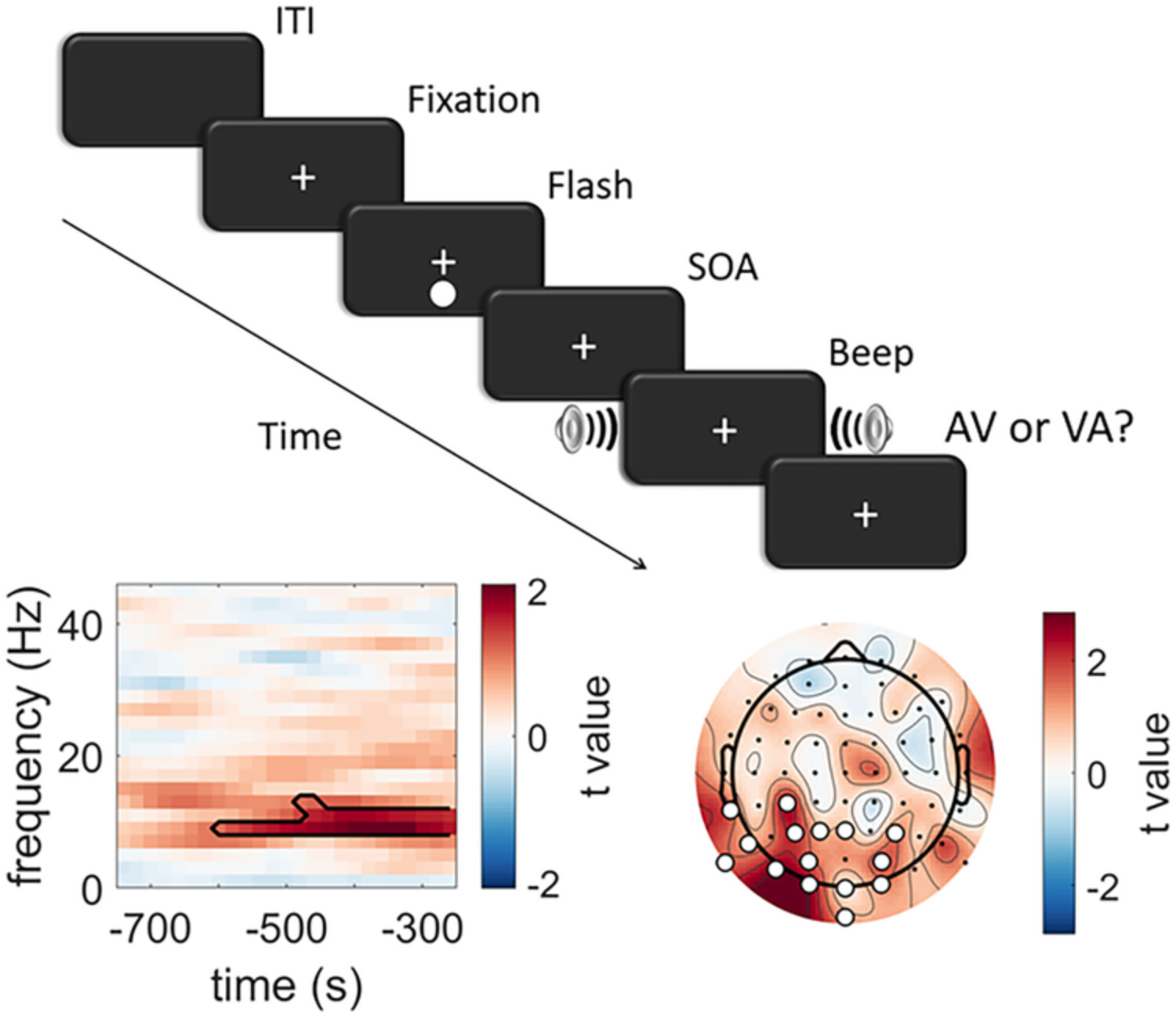
In an audiovisual temporal-order judgement task, we employed a novel jackknife procedure to quantify temporal sensitivity derived from a psychometric function at the single-trial level. We found that higher pre-stimulus alpha power predicted a lower temporal sensitivity, while instantaneous alpha frequency was not predictive of temporal sensitivity. Individual peak-alpha frequency did not correlate significantly with temporal sensitivity across participants nor did individual peak-alpha power.
Target enhancement or distractor suppression? Functionally distinct alpha oscillations form the basis of attention
- Pages: 3256-3265
- First Published: 11 May 2021
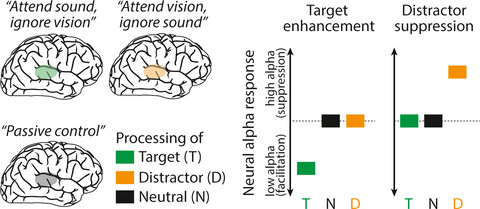
Recent advances in attention research have been propelled by the debate on target enhancement versus distractor suppression. A major neural correlate of attention is the modulation of alpha oscillatory power (~10 Hz), which signifies shifts of attention in time, space and between modalities. This opinion article reviews and critically examines conceptual and methodological key aspects that are indispensable for a mechanistic understanding of the role of neural alpha oscillations for attention.
SPECIAL ISSUE REVIEW
Forgotten rhythms? Revisiting the first evidence for rhythms in cognition
- Pages: 3266-3276
- First Published: 08 September 2021
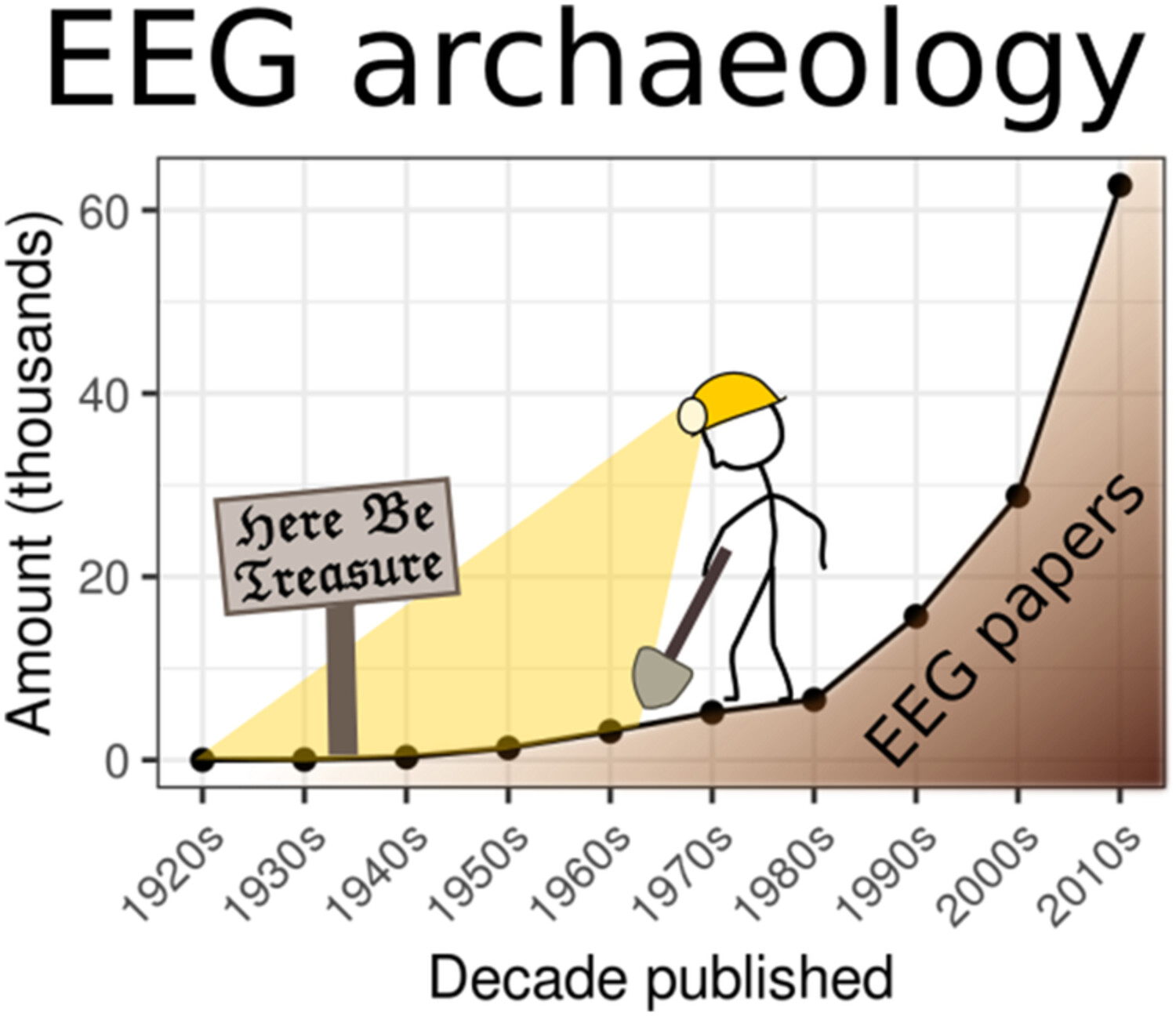
This article summarizes some of the early research into brain rhythms, focusing on work using repetitive visual stimulation, also known as photic driving. Links to contemporary open research questions are highlighted, particularly between photic driving results and current entrainment studies, as well as general arguments for reading historical literature.
SPECIAL ISSUE ARTICLES
Neural entrainment via perceptual inferences
- Pages: 3277-3287
- First Published: 22 February 2022
Degradation levels of continuous speech affect neural speech tracking and alpha power differently
- Pages: 3288-3302
- First Published: 20 July 2020
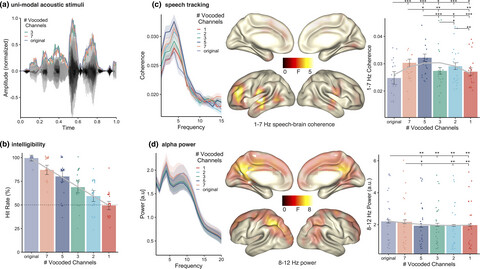
Recording magnetoencephalography while presenting continuous speech under different levels of degradation shows that alpha power and speech tracking are differently affected. While alpha power declines with declining clarity speech tracking follows an inverted U-shape. Linear mixed models suggest that a combination of alpha power and tracking contribute to subjective speech understanding.
SPECIAL ISSUE REVIEW
Integrating music-based interventions with Gamma-frequency stimulation: Implications for healthy ageing
- Pages: 3303-3323
- First Published: 24 November 2020
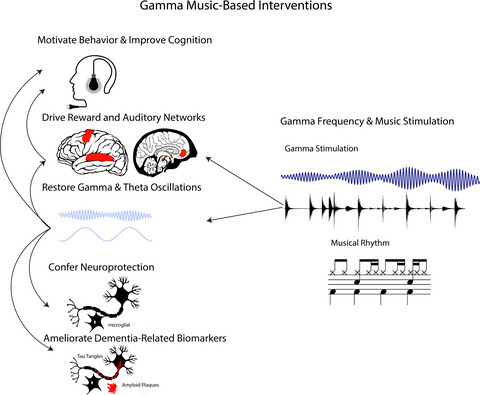
Here, we propose a novel clinical framework for non-invasively treating dementia-related disorders, called Gamma music-based interventions (Gamma-MBIs), that combines previous music-based interventions (MBIs) with current approaches employing Gamma-frequency sensory stimulation. We theorize that Gamma-MBIs could target multiple biomarkers of dementia, restore neural activity that underlies learning and memory (e.g., Gamma-frequency neural activity, Theta-Gamma coupling), and actively engage auditory and reward networks in the brain to promote behavioral change.
SPECIAL ISSUE ARTICLES
Temporal prediction elicits rhythmic preactivation of relevant sensory cortices
- Pages: 3324-3339
- First Published: 28 July 2021
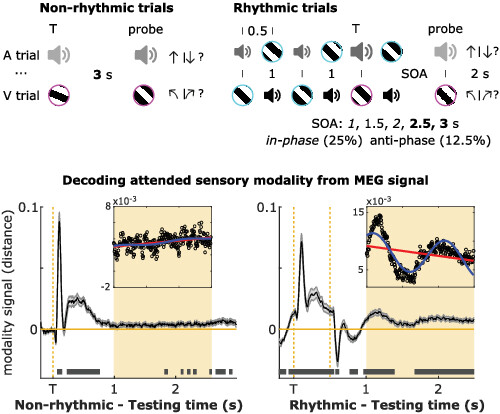
The brain extracts temporal regularities from the environment to anticipate upcoming events. Furthermore, with prior knowledge about their contents, the brain is thought to leverage this by instantiating anticipatory sensory templates. We investigated if sensory templates occur in response to a rhythmic stimulus stream with predictable temporal structure. We found that temporal rhythmic predictions did not induce sensory templates but rather modulated the excitability in early sensory cortices.
No effects of rhythmic visual stimulation on target discrimination: An online alpha entrainment experiment
- Pages: 3340-3351
- First Published: 30 September 2021

Rhythmic visual stimulation at alpha frequency (‘entrainment’) has previously led to modulated visual processing over SOAs, implying entrained alpha-phase effects. What about alpha power? We here found no differential effects of rhythmic as compared with arrhythmic stimulation in a reaction time task inspired by attention studies, aiming to test whether rhythmic alpha stimulation might modulate attention-related alpha power.
No behavioural evidence for rhythmic facilitation of perceptual discrimination
- Pages: 3352-3364
- First Published: 26 March 2021
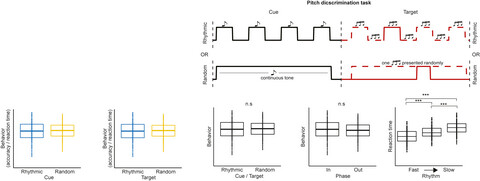
In a series of auditory pitch discrimination tasks with 181 healthy human participants, we provide no evidence for the popular hypothesis that entrainment to external rhythms (cues) facilitates perception and behavior. Instead, we found that behavior (reaction time) correlates positively with the frequency of these external rhythms. Thus, in a rhythmic environment covert active sensing, rather than entrainment, might underlie behavioral or perceptual improvements.
The effect of regular rhythm on the perception of linguistic and non-linguistic auditory input
- Pages: 3365-3372
- First Published: 30 October 2020
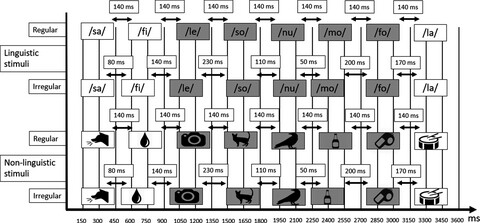
Neural oscillations sample the environment rhythmically. Environmental rhythms entrain neural rhythms and lead to resampling the world. Regularly distributed salient events lead to more attentional resources allocated to them, thus enhancing the probability of perceiving them. We expected regular acoustic rhythms to facilitate performance in sound- and syllable-monitoring tasks (non-linguistic and linguistic material). Facilitatory effect of regular rhythm was only detected on linguistic material, suggesting that isochrony modulates attention to linguistic more than to non-linguistic stimuli.
The impact of phase entrainment on auditory detection is highly variable: Revisiting a key finding
- Pages: 3373-3390
- First Published: 21 June 2021
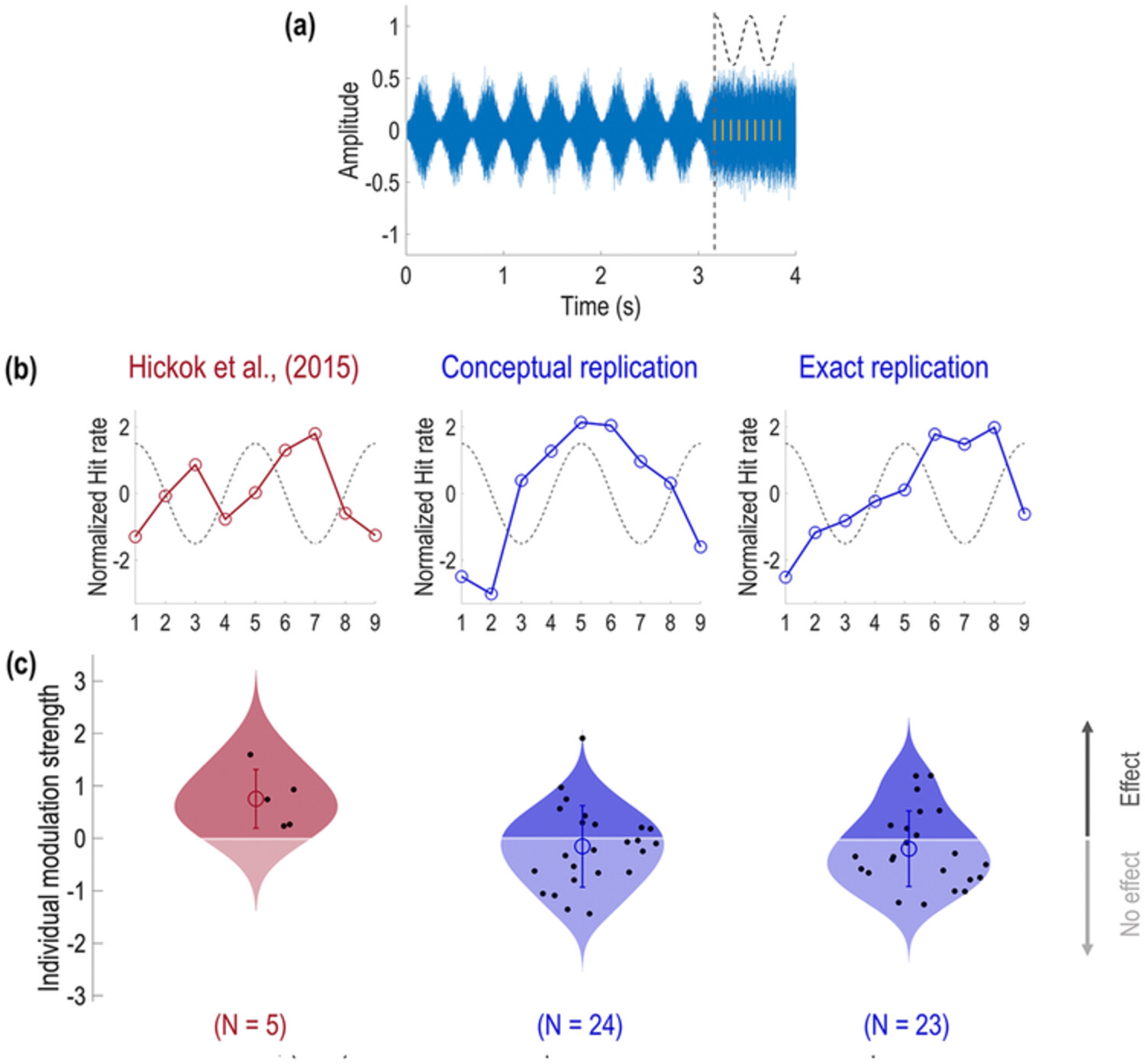
The current study revisited the entrainment effect observed in Hickok et al. (2015) (N = 5), by conducting a conceptual replication (N = 24) and an exact replication (N = 23). The original study showed that the detection of an acoustic target presented across nine temporal positions (a: yellow lines) following a sequence of amplitude modulated noise (a: blue curve to the left of the dashed line) exhibited a bicyclic modulation pattern (b: red graph) across the five tested participants (individual effect size in c: red graph). Results from our two experiments with larger sample sizes revealed that this modulation effect was only present in a subset of participants (~36%; c: black dots enclosed in dark blue areas) and was not observed at the group level (b: blue graphs).
SPECIAL ISSUE ARTICLE
Intertap interval dependence of the subdivision effect in auditory-synchronised tapping
- Pages: 3391-3401
- First Published: 11 November 2021
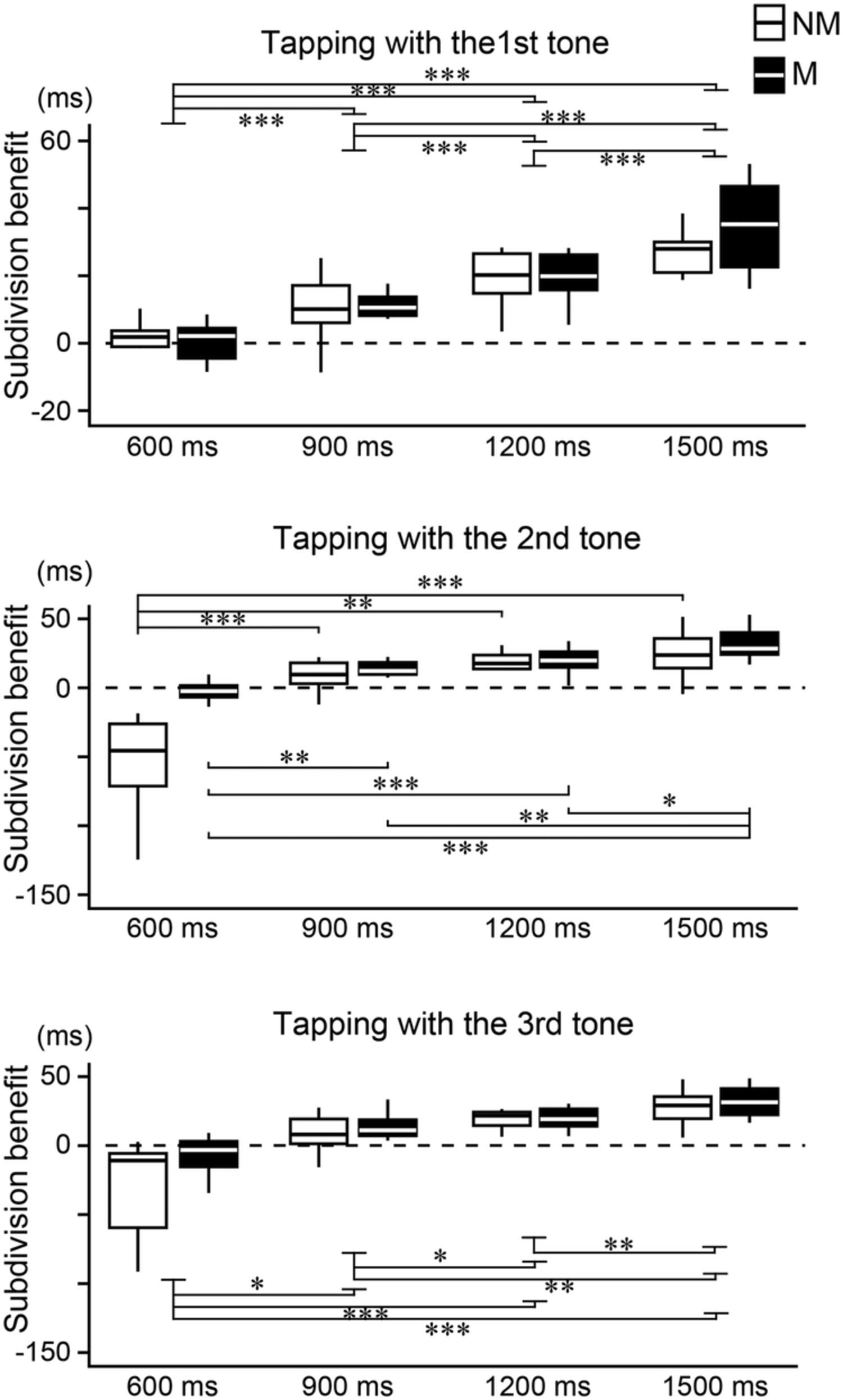
We conducted a behavioural experiment to investigate the psychological mechanisms of sensory–motor synchronisation by introducing a rhythmic structure using a subdivision in a tone sequence. Subdivided tones made synchronised tapping less variable than a simple repetition of a tone when the intertap interval was 900 ms or more. On the other hand, a shorter intertap interval of 600 ms caused synchronisation more variable.
SPECIAL ISSUE REVIEW
Discrete sampling in perception via neuronal oscillations—Evidence from rhythmic, non-invasive brain stimulation
- Pages: 3402-3417
- First Published: 13 October 2020
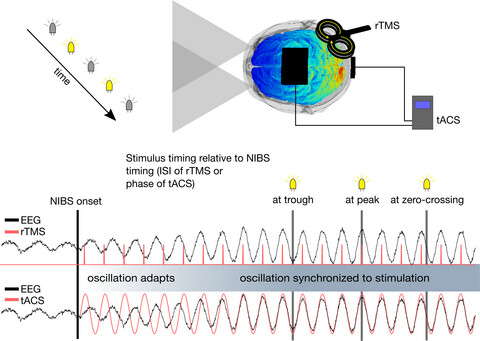
It has long been debated whether neural oscillations may implement a discrete sampling process in perceptual systems of the brain. Rhythmic, non-invasive brain stimulation (rNIBS) is increasingly used to test this hypothesis. In this review, we introduce the basic concepts of rNIBS methods in the study of perception, overview different experimental approaches along with their findings, and discuss their methodological pitfalls and limitations.
SPECIAL ISSUE ARTICLES
Calibrating rhythmic stimulation parameters to individual electroencephalography markers: The consistency of individual alpha frequency in practical lab settings
- Pages: 3418-3437
- First Published: 07 August 2021
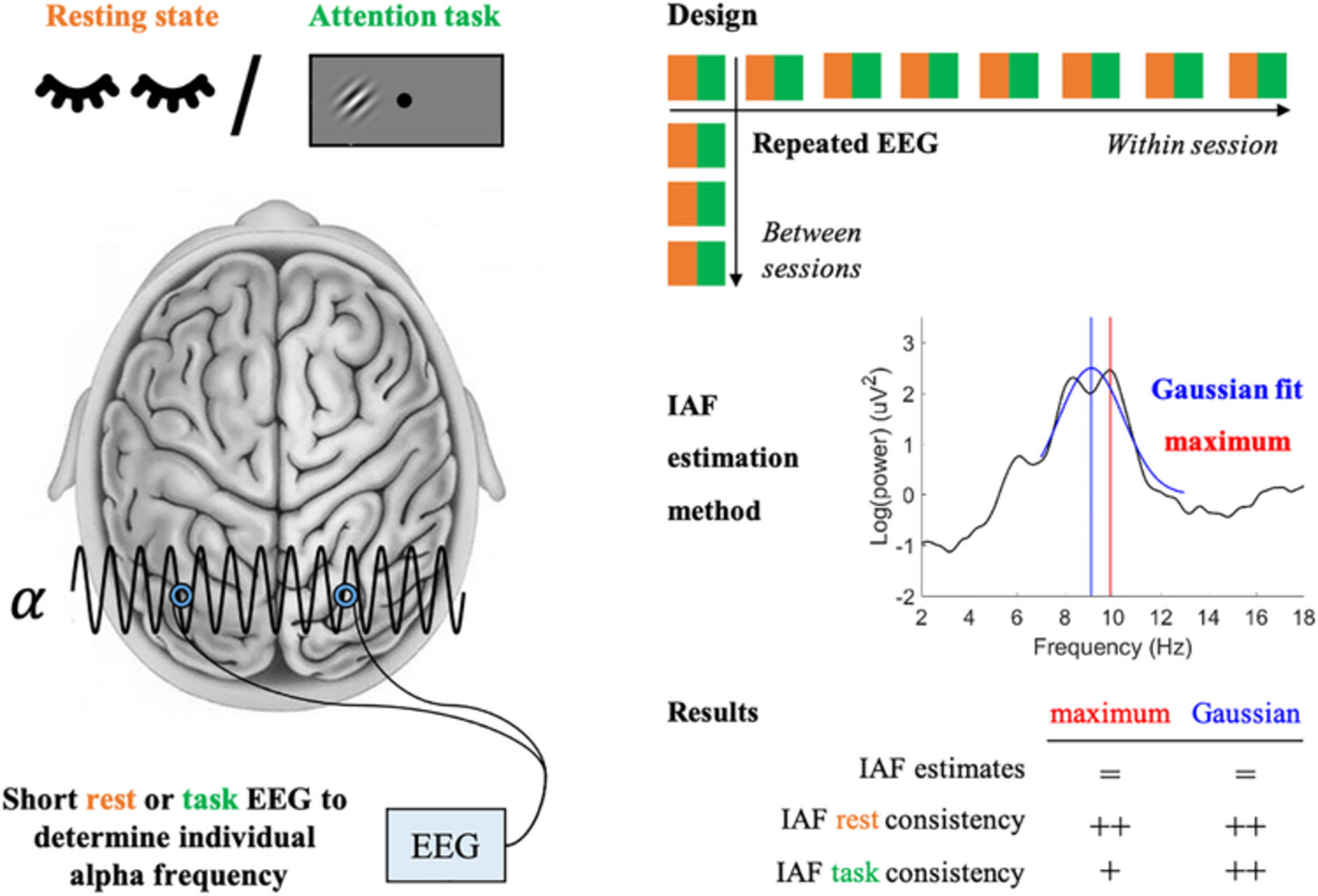
We repeatedly measured electroencephalography (EEG) between- and within-sessions, during resting state and attention task, from two posterior electrodes. The ‘maximum’ method on average yielded the same individual alpha frequency (IAF) estimates as a ‘Gaussian fit’ method, but the latter was more consistent, and rest-IAF was more consistent than task-IAF. When calibrating rhythmic stimulation protocols to individual EEG markers, we thus recommend rest-EEG along with a Gaussian fit method.
Testing the effect of tACS over parietal cortex in modulating endogenous alpha rhythm and temporal integration windows in visual perception
- Pages: 3438-3450
- First Published: 23 October 2020
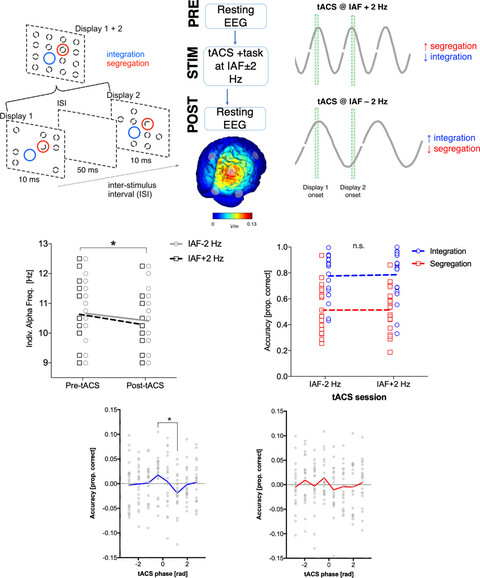
Alpha oscillations (8–12 Hz) have been related to temporal sampling in vision. After estimating the individual alpha frequency (IAF) from the electroencephalogram, we delivered transcranial alternating current stimulation (tACS) at slightly slower and faster frequencies (±2 Hz), whereas the participants performed a temporal integration/segregation task. Contrarily to our hypothesis, right-parietal tACS did not increase/decrease the IAF and did not lead to a modulation of the integration/segregation performance. Nonetheless, we observed preliminary evidence for an influence of tACS phase on temporal integration.
Alpha modulation in younger and older adults during distracted encoding
- Pages: 3451-3464
- First Published: 15 December 2020
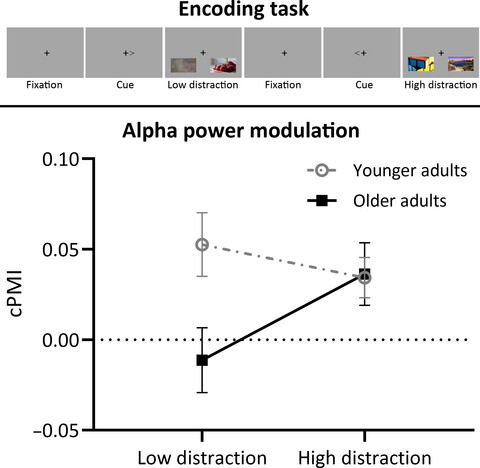
Here we show that both older and younger adults are able to encode targets paired with distractors into long-term memory. Also, we demonstrate that older adults only modulated alpha power during high distraction. These results indicate that both younger and older adults are able to employ the same inhibitory control mechanisms successfully, but that older adults fail to call upon these when distraction is minimal.
Neuronal correlates of the subjective experience of attention
- Pages: 3465-3482
- First Published: 19 July 2021
Phase-amplitude coupling profiles differ in frontal and auditory cortices of bats
- Pages: 3483-3501
- First Published: 26 September 2020
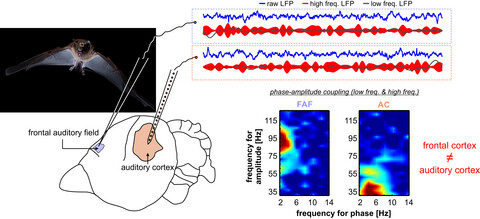
Phase-amplitude coupling was studied in an auditory region of the frontal cortex and the auditory cortex of bats. Coupling profiles differed across structures, with prominent delta/high-gamma coupling in frontal regions, and strong delta-theta/low-gamma coupling in auditory cortex. Distinct profiles may represent different mechanisms for neuronal processing in frontal and auditory cortices, and might complement oscillatory interactions for sensory processing in fronto-auditory cortical networks.
SPECIAL ISSUE TECHNICAL SPOTLIGHT
Methodological considerations for studying neural oscillations
- Pages: 3502-3527
- First Published: 16 July 2021
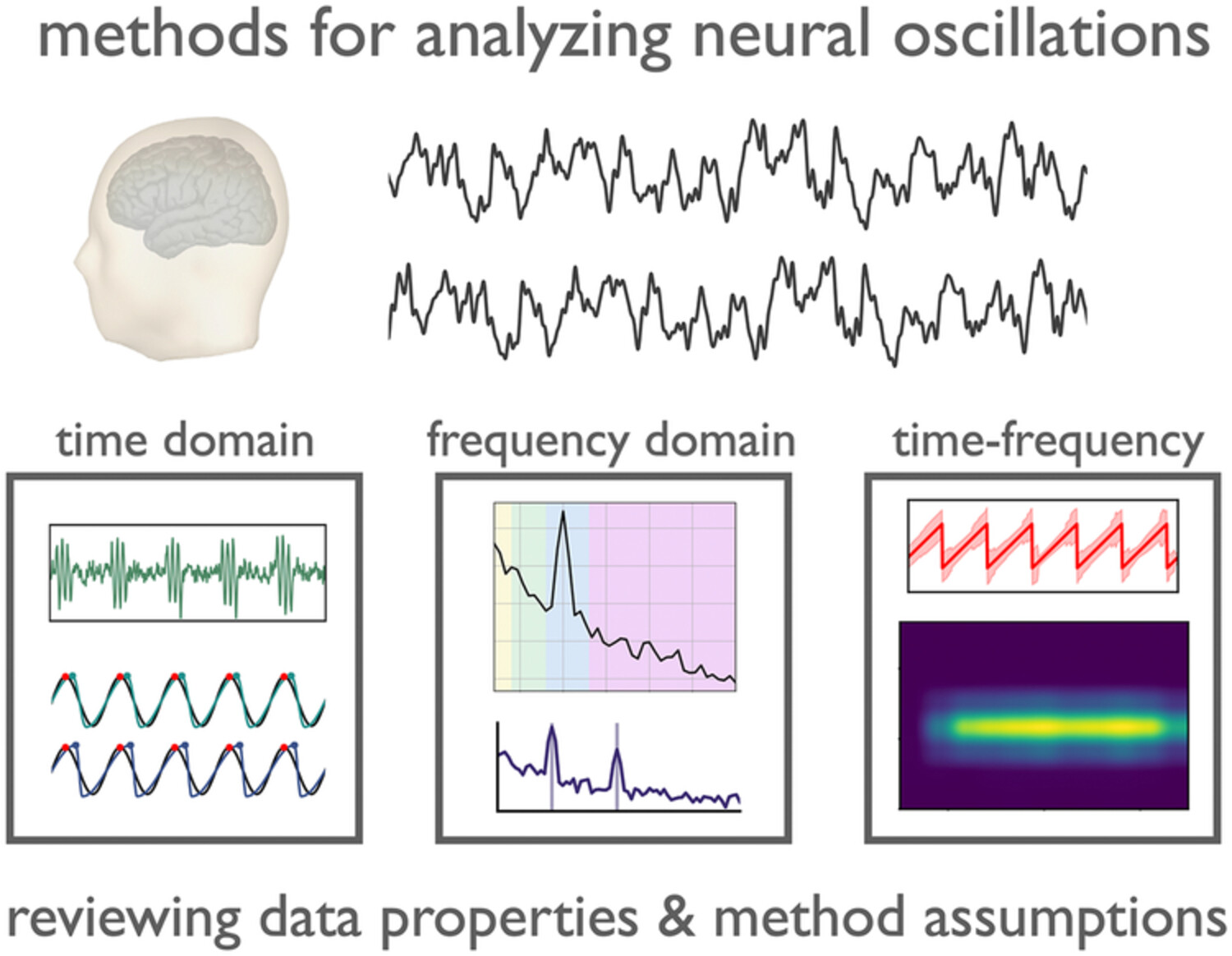
Neural oscillations are ubiquitous features of neural field data, with great potential for informing our understanding of neural function and how it relates to cognition. However, there is a great degree of variability in methods for investigating them, and findings that are reported. In this piece, we explore methodological considerations for analysing neural oscillations that may underlie some potential misinterpretations and propose best practice guidelines for addressing them.
SPECIAL ISSUE ARTICLE
A guideline for linking brain wave findings to the various aspects of discrete perception
- Pages: 3528-3537
- First Published: 14 June 2021
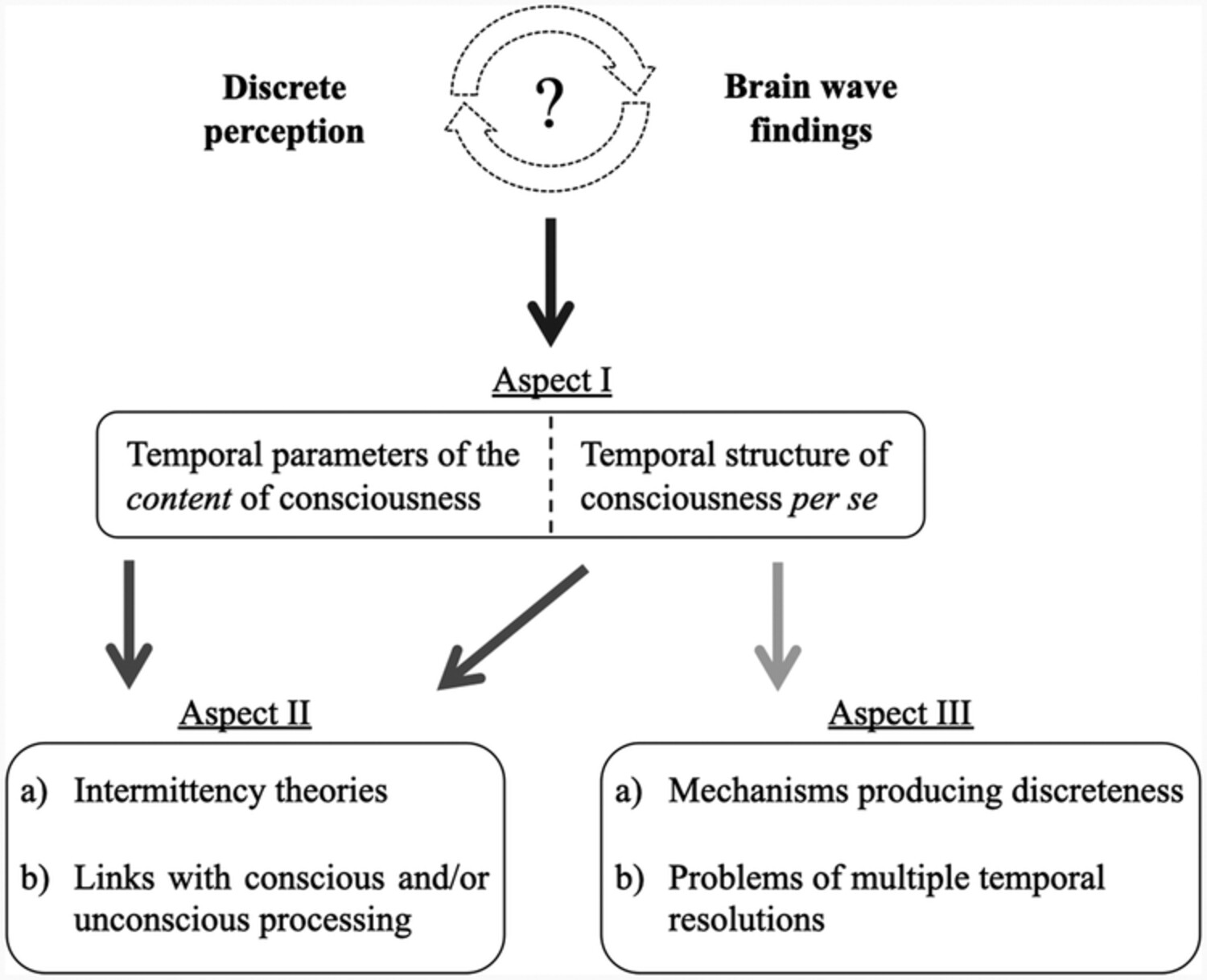
What aspects of discrete perception theories are addressed when brain wave findings are related to discrete perception? The first aspect we propose requires clarifying whether findings are about the content of consciousness or the temporal structure of consciousness per se. The second aspect requires specifying the choice of intermittency theory and its consequences on conscious and unconscious processing. The third aspect requires showing whether sampling in discrete perception is necessarily linked to specific brain rhythms and addressing the issue of multiple temporal resolutions.





